
ISSN: 3005-8198 (online) / 3005-818X (print)
Volume 1, Issue 1, pp: 30-37
![]()
The Effect of Using Different Cross-Sectional Shapes of Steel
on the Flexural Performance of Composite Reinforced Concrete Beams
Hanadi Elkhansa1, Firas Barraj2*, Youssef Sami Sleiman 3, Ali Zaid Moghnieh 1
1 Department of Civil and Environmental Engineering, Islamic University of Lebanon, P.O. Box 30014, Beirut, Lebanon.
E-mail: hanadi_khansa@hotmail.com; alimoghniehzaid@hotmail.com
2Department of Civil and Environmental Engineering, University of Balamand, P.O. Box 100, Al Koura 1304, Lebanon.
Email: firas.barraj@balamand.edu.lb
3 Department of Civil and Environmental Engineering, University of Polytech Lille, France.
Email: sleimanyoussef99@gmail.com
* Correspondence Author
Received: 18 July 2023 | Revised: 15 August 2023 | Accepted: 29 August 2023 | Published: 2 September 2023
Various types of structures can be constructed using reinforced concrete, including slabs, walls, beams, columns, foundations, frames, and more. The incorporation of structural steel and reinforcements in concrete enhances the strength and durability of structural elements while compensating for the tensile weaknesses in the concrete material. This study aimed to investigate the behavior of reinforced concrete beams utilizing structural steel of different shapes. Four types of concrete beams were prepared: a standard beam with normal reinforcement, and three composite beams, each featuring structural steel with different sectional shapes – T-section, I-section, and channel section. The consistent parameters included the cross-sectional area of the specimens, each measuring 100x150x450 mm, a steel reinforcement percentage of 2% of the total volume, and the compressive strength of the concrete. The conducted tests involved applying a concentrated load at the mid-span of each beam to examine the specimens’ behavior in terms of strength, flexural load capacity, deflection, crack patterns, and failure mode. The results of this study reveal that, given the same steel ratio, the load capacity of beams reinforced with structural steel of a channel shape has surpassed that of the other beams. Additionally, specimens with structural steel plates exhibited higher maximum deflections before failure compared to the beams with conventional reinforcement.
Keywords: Sustainability, Steel sections, flexural load capacity, failure mode, deflection, compressive strength.
Reinforced concrete (RC) is widely used in the construction industry due to its high compressive strength and durability (Ramadan et al., 2022; Ramadan et al., 2023). It can be utilized to construct various types of structures, including slabs, walls, beams, columns, foundations, and frames (Elwood & Eberhard, 2009; Priestley et al, 1994; Park & Gamble,1996; Schladitz et al., 2012). Concrete components and sections found common application in buildings, bridges, and other infrastructure projects (Alhakim et al., 2023; Hatoum et al., 2022; Barraj et al., 2022). The use of steel reinforcement in concrete beams is essential for improving their load-carrying capacity and preventing premature failure (Noguchi et al., 2014; Li et al., 2020). This design practice empowered the sustainable development sought in different engineering sectors (Barraj et al., 2022; Hatoum et al., 2022; Elkordi et al., 2022; Mahfouz et al., 2022).
The shape of reinforcement has a significant impact on the behavior of beams under various loading conditions. Encased beams, which comprise a steel beam encased within a concrete shell, have found application as rigid reinforcement in deck bridges for railway reconstruction projects and building with limited heights (Kamal, 2015; Joshi et al., 2016). However, these beams rarely undergo design or structural modifications, despite their extensive history of use. Standard verifications of these structures have unveiled the inefficient utilization of traditional I-beams alone (Hosseinpour et al., 2018; Ranzi et al., 2013).
To address this issue, researchers have undertaken the design and evaluation of RC beams using steel reinforcement with various shapes (Yang et al., 2016; Khare et al., 2016; Soundararajan et al., 2008). For example, Wehbi et al. (2021) investigated the flexural behavior of encased composite beams using steel with T-sections (ST) and steel with pipe (SP) sections. The study demonstrated that the shape of the steel reinforcement impacts the flexural behavior of RC beams, with ST specimens exhibiting more favorable behavior in terms of ultimate capacity and ductility compared to SP specimens. ElBasha et al. (2018) explored the effectiveness of hollow reinforced concrete encased steel tube (CEST) composite beams. The study revealed that the bending strength and flexural stiffness of the hollow CEST section increase with the height of the steel tube, resulting in higher maximum strength compared to conventional solid RC beam specimens. Lathasha and Abraham (2019) conducted an analytical study on the flexural behavior of composite slim floors using different steel sections, including symmetrical I- sections, channel sections, angle sections, and asymmetrical I-sections with equivalent cross-sectional areas. They concluded that the partially encased slim floor with angle sections exhibits higher moment capacity due to the greater strength of its bottom flange. Other investigations have explored various aspects of RC beams. Ali et al. (2012) investigated the structural behavior of concrete-encased composite beams under lateral loading, emphasizing the influence of the steel beam core. Kamal (2015) analyzed the effect of the upper steel section flange position on beam capacity and ductility. P. Fouche’ et al. (2017) scrutinized the inelastic behavior of concrete-filled double-skin steel tubes (CFDSTs) as an alternative to RC columns for bridge piers in scenarios involving multiple hazards. The experimental investigation demonstrated that CFDSTs exhibit substantial toughness and ductility, rendering them suitable for satisfactory performance under seismic and blast hazards.
Abbas (2021) scrutinized the flexural strength of composite beams employing non-weldable top-hat steel plate sections as connectors. He observed that beams with a 4mm channel connection exhibited the highest load-carrying capacity and reduced mid-span deflection. Liu et al. (2017) investigated U-shaped steel girders and angle connectors in steel-concrete composite beams, revealing improved flexural performance and cost savings by obviating the necessity for shear stud connectors. Zhong et al. (2017) demonstrated that the installation of a channel steel plate at the head of a notch in concrete beams enhances crack resistance and augments load capacity. The steel plate redirects crack initiation away from the tip, diminishing tensile stress concentration and enhancing the load-carrying capacity. The study emphasized the significance of augmenting the fracture energy of the concrete material and demonstrated a more gradual load-deformation response with the presence of steel plate reinforcement. The size of the steel plate has negligible effects on the load capacity. NANDHINI et al. (2017) discovered that encased beams with channel steel sections as main reinforcement outperform ordinary beams with normal steel reinforcement concerning flexural strength. The flexural strength of encased reinforced beams was higher compared to ordinary reinforced beams. Al-Hadithy et al. (2012) concluded that the use of horizontal transverse-bar shear connectors in reinforced T-beams heightens both the ultimate moment capacity and flexural stiffness of the beam.
Additional techniques, including the incorporation of web openings in steel plates and the use of hybrid fiber-reinforced polymer composite beams, have demonstrated significant enhancements in load capacity, crack resistance, and flexural performance, presenting promising opportunities for the construction industry (Nie et al., 2003; Ferreira et al., 2020; Nordin & Täljsten, 2004). These findings underscored the significance of meticulous design considerations and the adoption of appropriate reinforcement strategies to optimize the structural integrity and performance of composite beams (Grover & Sakshi, 2016). Ongoing research and experimentation in this domain will continue to contribute to the development of effective and cost-efficient solutions for enhancing the strength and durability of composite structures.
The objective of this study was to investigate the distinctions in behavior between a conventional concrete beam reinforced with steel bars and encased composite beams utilizing structural steel with varying shapes. Experimental testing was carried out on a range of beams to achieve the following goals:
The test specimens comprised of two duplicated RC beams featuring conventional rebars, serving as the control group. Additionally, there were six other RC beams incorporating structural steel of different shapes. This encompassed two beams with T-section structural steel plates, two beams with channel-section structural steel plates, and two beams with I-section structural steel plates. All the specimens, as outlined Table 1, were uniform in dimensions (100x150x450mm) and possessed an identical percentage of steel reinforcement (2% of the concrete’s cross-sectional area).
Table 1. Characteristics of the testing specimens.
Sample | BR (Control beam) | BT (inverted T-section) | BU (U-section) | BI (I-section) |
Percentage of steel from total area (%) | 2% | 2% | 2% | 2% |
Width of beam (b) (cm) | 10 | 10 | 10 | 10 |
Depth of beam (d) (cm) | 15 | 15 | 15 | 15 |
Width of top flange of structural steel (cm) | – | – | – | 5 |
Thickness of top flange of structural steel (cm) | – | – | – | 0.2 |
Width of bottom flange of structural steel (cm) | – | 5 | 5 | 5 |
Thickness of bottom flange of structural steel (cm) | – | 0.2 | 0.2 | 0.2 |
Height of the web of structural steel (cm) | – | 10 | 5 | 5 |
Thickness of the web of structural steel (cm) | – | 0.2 | 0.2 | 0.2 |
Concrete cover (cm) | 2.5 | 2.5 | 2.5 | 2.5 |
Figures 1, 2, 3 and 4 show the cross-sections of the control beam samples (C-1 & C-2), the inverted T-section samples (T-1 & T-2), the channel-section samples (U-1 & U-2) and the I-section samples (I-1 & I-2).
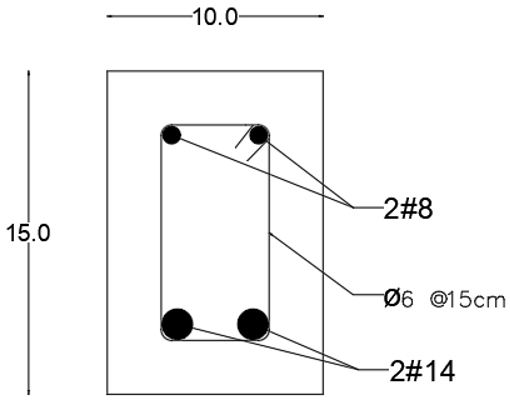
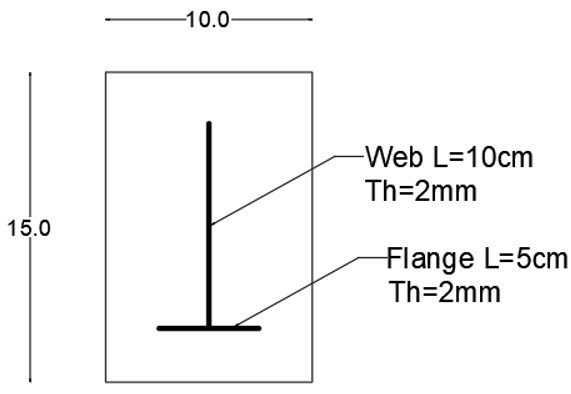
Figure 1. Control Beam (C).
Figure 2. Beam with T-section (T).
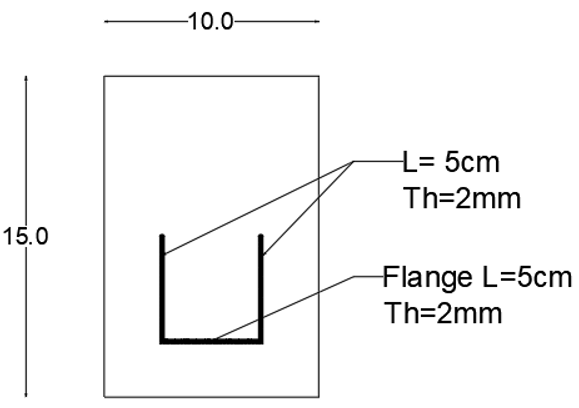
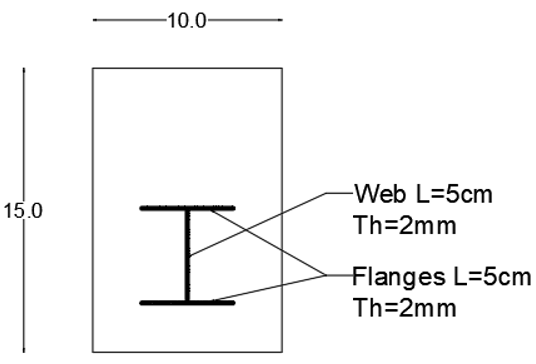
Figure 3. Beam with channel section (U).
Figure 4. Beam with I-section (I).
The concrete employed for the beams possessed a compressive strength of 23 MPa and was sourced from a local ready-mix plant. The structural steel plates used in the beam samples exhibited a yield strength of 162 MPa and an average modulus of elasticity of 211,000 MPa.
For the concrete compressive strength testing of the cylinders, the MATEST C089-21N concrete compression testing machine was employed (refer to Figure 5). This machine boasts a capacity of 2000 KN, high stability, and features motorized operation facilitated by Autotec control unit. Furthermore, the flexural tests on concrete beams were conducted using the flexural device (depicted to Figure 6). The machine is equipped with the UTM2 software (Universal Testing Machine 2), specifically developed for the remote control and management of MATEST testing machines from a PC. It is licensed for executing flexure tests on concrete.
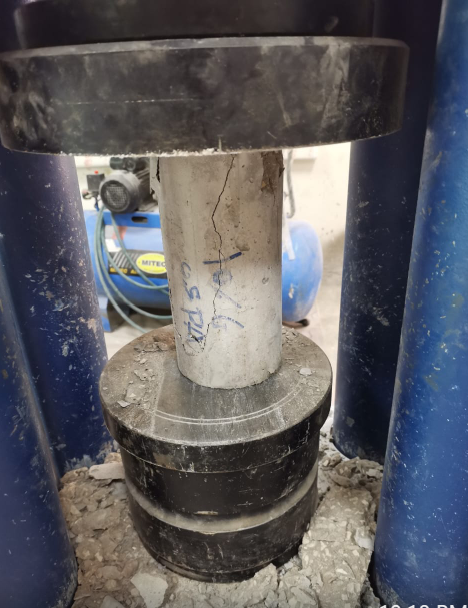
Figure 5. Concrete compression testing machine
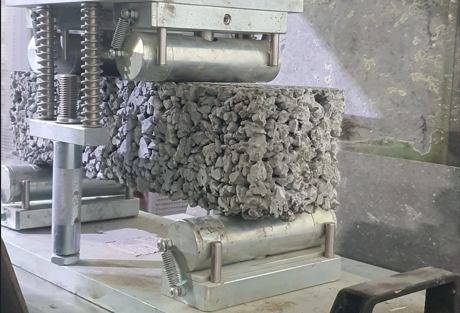
Figure 6. Flexural device
All specimens underwent testing after a curing period of 28 days. Each beam was subjected to a concentrated load applied at its mid-span, as sketched in Figure 7. Subsequently, the load – deflection curve was plotted to track the behavior throughout the elastic, plastic, and damaged phases of the beam. A comprehensive analysis was carried out, comparing the strength, stiffness, load capacity, deflection, and failure mode of the different beams within the study.
The load-deflection curves for the control beams C-1 and C-2, as well as the composite beams T-1, T-2, I-1, I-2, U-1, and U-2 are presented in Figure 7.
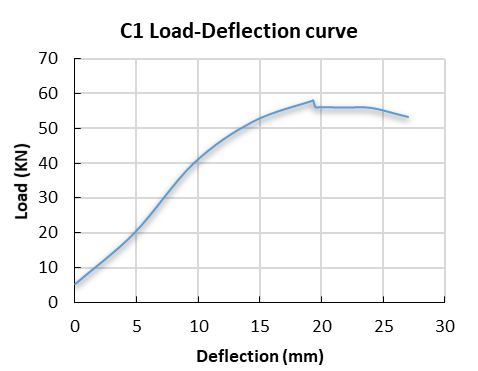

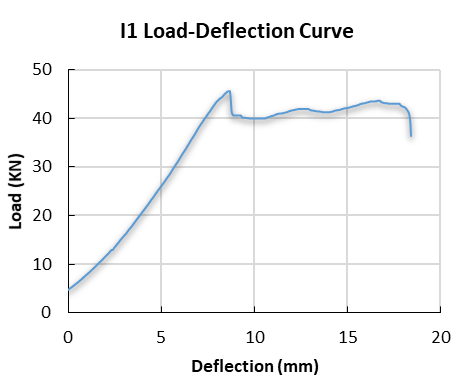


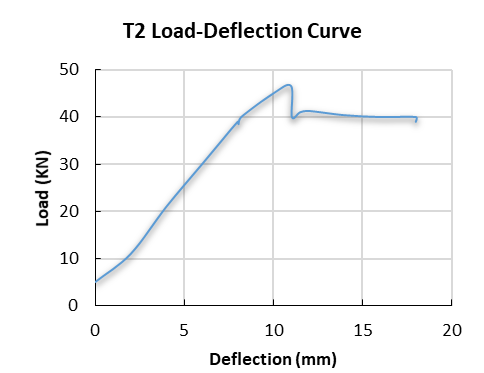
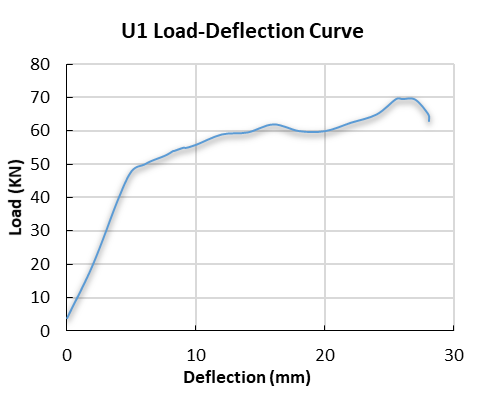
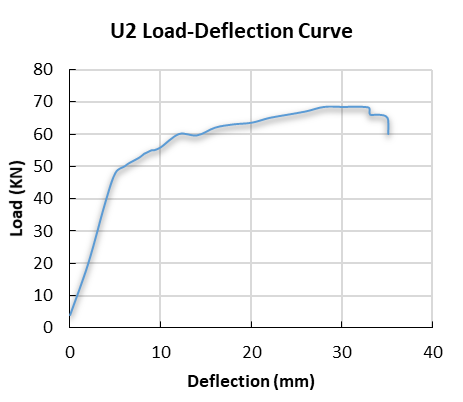
Figure 7. Load-deflection curves for the control and the composite beams
The experimental results of the composite beams and the control beam tested in this study are provided in Table 2 and Table 3, respectively.
Table 2. Results from testing.
Beam | First Crack at Load (KN) | Yield Load (KN) | Ultimate Load (KN) | Maximum deflection (mm) |
C-1 | 40 | 44 | 58.2 | 26 |
C-2 | 44 | 54 | 59.2 | 18 |
T-1 | 38 | 39 | 42 | 14 |
T-2 | 39 | 42 | 46.584 | 18 |
I-1 | 40 | 43 | 45.588 | 19 |
I-2 | 42 | 44 | 53.178 | 26 |
U-1 | 61.5 | 64 | 69.639 | 29 |
U-2 | 61 | 63.5 | 68.454 | 35 |
Table 3. Average Loads to first crack and yielding.
Beam | Py avg (KN) | Avg. Load at first crack (KN) |
C | 49 | 42 |
T | 40.5 | 38.5 |
I | 43.5 | 41 |
U | 63.75 | 61.25 |
Analyzing the outcomes presented in Table 3, a significant observation emerged: among the beams with same steel ratio, the initial appearance of cracks in composite beams that incorporate U-shaped structural steel plates occurred at a load of 61.75 KN, surpassing the other beams, suggesting a superior load-carrying capacity. As the applied load increased towards the yield point (Py), the steel’s tensile flange exhibited yielding behavior. The composite beams incorporating U-shaped structural steel plates exhibited the best yielding load of 63.75 KN, a noteworthy 23.13% higher than that of the control beams.
With further load increment, the concrete experienced deformation leading to its ultimate load capacity (Pu). Subsequently, the propagation of flexural cracks persisted until reaching the point of failure.
Figure 9 shows that the average ultimate load capacity of the control beam surpasses that of the composite beams with inverted T sections by 32.5%, and it also surpasses the composite beams with I sections by 18.8%. Nonetheless, the beams incorporating U-shaped steel exhibit a heightened load capacity, outperforming the control beam by17.6%. These findings align with those of previous studies conducted by Khare et al. (2016) and Nandhini et al. (2017) (khare et al., 2016) and (Nandhini et al., 2017).

Figure 8. Average Ultimate Load Comparison.
Figure 9 illustrates the deflection of both the control beam and the composite beams featuring a steel ratio of 2%. It’s apparent that the composite beams incorporating I-section and U-section structural steel shapes exhibit a higher maximum deflection before failure compared to the control beam. This corresponds to an increase of 2.3% and 45.45% respectively. Conversely, the control beam could display higher ductility than the composite beams with inverted T-section structural steel, showing a difference of 37.5%. These observations suggest that the composite beams incorporating U-shaped structural steel might possess superior ductility when compared to all other beams types.
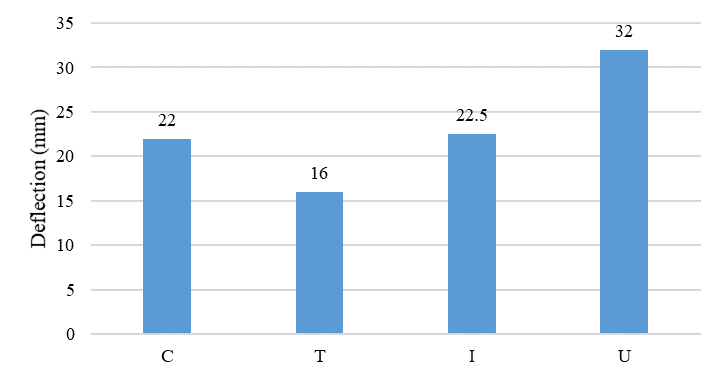
Figure 9. Maximum Deflection Comparison.
Figures 10 to 12 depict the crack propagation within the samples. These cracks originated from the beam’s bottom, specifically within the tension zone, and extended towards the surface corresponding to the compression zone. The majority of cracks were concentrated near the supports area. As the applied load increased, these initial cracks gradually widened until reaching the point of beam failure, resulting in the formation of a plastic zone. Upon failure, the cracks exhibited an angle of 45˚, indicative of a ductile failure mode. However, in the case of the composite beams featuring inverted T-sections, the cracks initiated near the loading point and exhibited a brittle failure pattern, as portrayed in Figure 13.
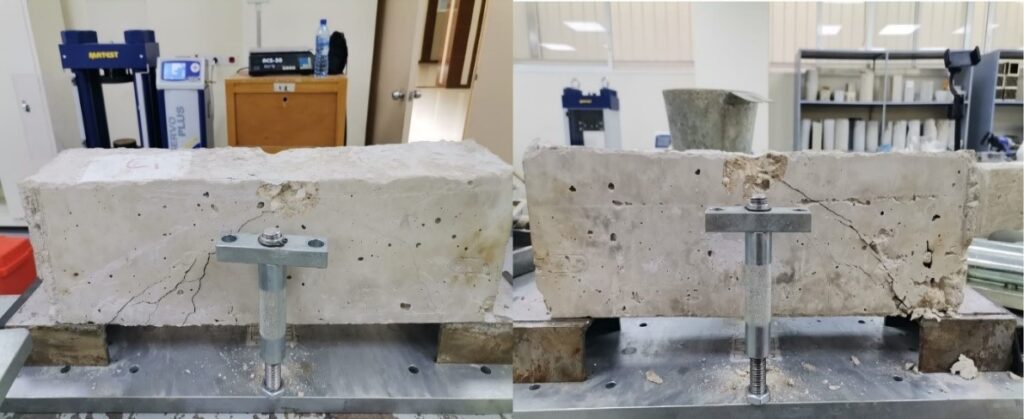
Figure 10. Control beam Cracks.
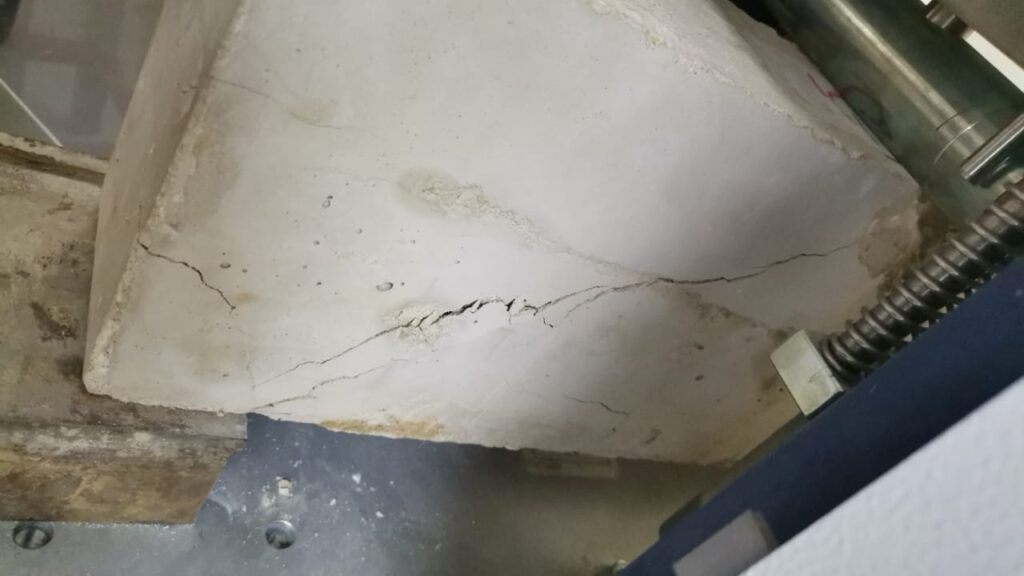
Figure 11. Beam B3 (I-section) Cracks
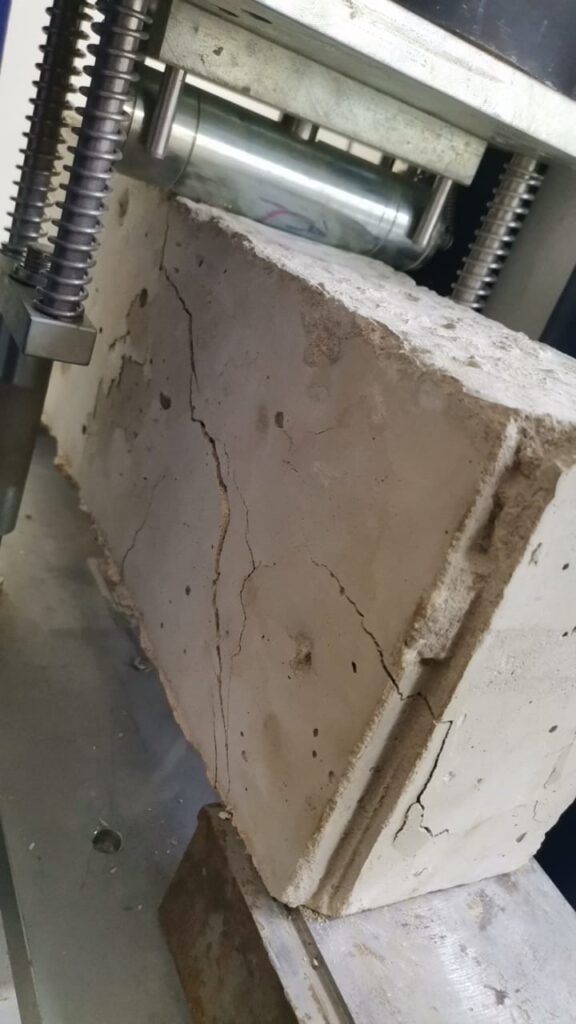
Figure 12. Beam B4 (U-section) Cracks

Figure 13. Beam B2 (inverted T-section) Cracks.
For the study, four distinct beams were cast, each featuring a unique type of reinforcement. Despite the differences in reinforcement, all beams shared an identical steel volume percentage relative to the concrete. Specifically, two specimens were prepared for each beam type, encompassing ordinary reinforcement, inverted T-section structural steel plates, channel-section structural steel, and I-section structural steel plates. In the laboratory setting, these beams underwent testing with a concentrated load applied at their mid-span. Subsequently, a comprehensive comparative analysis was conducted to evaluate and compare the behavior of the specimens across various parameters, including strength, flexural load capacity, deflection, crack patterns, and failure modes.
The key conclusions drawn from the study are summarized as follows:
To enhance the results of similar experiments, the following recommendations are proposed:
The authors express their sincere gratitude for the contributions and active participation of all individuals who played a role in the successful completion of this project. They also extend thanks to the board of research for their valuable support, as well as to the dedicated lab members and other individuals who provided assistance throughout the process.
Cite: Barraj, F., Elkhansa, H., Sleiman, Y. S., & Moghnieh, A. Z. (2023). The Effect of Using Different Cross-Sectional Shapes of Steel on the Flexural Performance of Composite Reinforced Concrete Beams. Steps For Civil, Constructions and Environmental Engineering, 1(1), 30–37. https://doi.org/10.61706/sccee120114
Copyright: © 2023 by the authors. Licensee SSG, Dubai, UAE.
This article is an open access article distributed under the terms and conditions of the Creative Commons Attribution (CC BY-NC-ND 4.0) license (http://creativecommons.org/licenses/by-nc-nd/4.0/).






An independent academic publisher with an editorial team including many of the top researchers in the world. SSG publishes research, review, and case report articles in double-blind, peer-reviewed, open access scientific and academic journals.
Copyright © 2023 Scientific Steps International Publishing Services LLC (Dubai – United Arab Emirates)